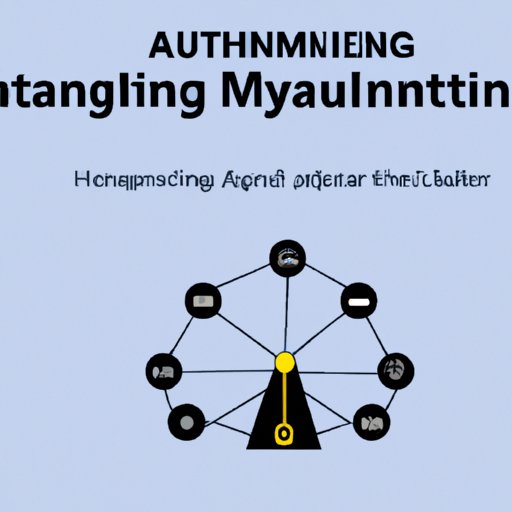Introduction
AI algorithms are computer programs that use mathematical models to solve complex tasks or problems. They are designed to mimic the cognitive abilities of humans and can be used for a variety of applications, from facial recognition to autonomous driving. This article will provide an overview of AI algorithms and explain how they work in detail.
Explaining AI Algorithms: A Step-by-Step Guide
In order to understand how AI algorithms work, it’s important to first understand what an AI algorithm is. An AI algorithm is a set of instructions that tells a computer how to perform a task or solve a problem. The instructions are written in a programming language and can be used to automate processes, such as recognizing patterns or making predictions.
Once you have a basic understanding of what an AI algorithm is, you can start to explore how AI algorithms work. To do this, it’s important to understand the different components and processes involved in AI algorithms. In the next section, we’ll examine these components and processes in more detail.

An Overview of AI Algorithms and Their Uses
AI algorithms are used in a variety of fields, from finance and healthcare to robotics and gaming. There are three main types of AI algorithms: supervised learning algorithms, unsupervised learning algorithms, and reinforcement learning algorithms. Each type of algorithm has its own unique set of capabilities and applications.
Supervised learning algorithms are used to classify data and make predictions. They are trained using labeled data, which means that the data is already labeled with the correct output. Examples of supervised learning algorithms include decision tree algorithms and support vector machines (SVMs).
Unsupervised learning algorithms are used to find patterns in data without any prior knowledge or labels. They are often used for clustering data or segmenting images. Examples of unsupervised learning algorithms include k-means clustering and self-organizing maps.
Reinforcement learning algorithms are used to learn from experience. They are trained using rewards and punishments to determine the best course of action. Examples of reinforcement learning algorithms include Q-learning and deep Q-networks (DQNs).

Types of AI Algorithms and How They Work
Now that you understand the different types of AI algorithms and their uses, let’s take a look at how they work. AI algorithms typically follow a similar process, regardless of the type of algorithm being used.
The first step is data collection. This involves collecting the data that will be used to train the algorithm. The data should be relevant to the task the algorithm is attempting to accomplish. For example, if the algorithm is being used to recognize objects in an image, the data should be images of those objects.
The next step is data pre-processing. This involves preparing the data for use by the algorithm. This may involve cleaning the data or transforming it into a format that the algorithm can use. For example, if the data is in the form of text, it may need to be converted into numerical values.
The third step is model selection. This involves choosing the appropriate model for the task. Different models have different capabilities and may be better suited for certain tasks. For example, a convolutional neural network (CNN) might be better suited for image recognition tasks than a linear regression model.
The fourth step is training the model. This involves feeding the data into the model and adjusting the parameters of the model to optimize its performance. This is done using optimization techniques, such as gradient descent or backpropagation.
The fifth step is evaluation. This involves testing the model on unseen data to see how well it performs. If the performance is not satisfactory, the model can be adjusted and re-trained until it reaches the desired level of performance.

Understanding the Processes Behind AI Algorithms
In addition to the steps outlined above, there are several other processes that are involved in AI algorithms. These include feature engineering, hyperparameter tuning, and optimization techniques. Feature engineering involves selecting the most relevant features from the data that will be used to train the model. Hyperparameter tuning involves adjusting the parameters of the model to optimize its performance. Optimization techniques involve using algorithms to find the optimal solution to a given problem.
Exploring the Benefits of AI Algorithms in Everyday Life
AI algorithms offer a number of advantages over traditional methods of problem solving. One of the main benefits is automation. AI algorithms can automate processes such as data analysis and pattern recognition, allowing businesses to save time and money.
AI algorithms also offer improved accuracy and precision. By using AI algorithms, businesses can make decisions based on accurate and up-to-date data, leading to better outcomes. Finally, AI algorithms can help reduce operational costs by automating processes and reducing the need for manual labor.
Conclusion
In conclusion, this article has provided a comprehensive guide to understanding how AI algorithms work. We explored the different types of AI algorithms and examined the components and processes involved in AI algorithms. We also explored the benefits of AI algorithms in everyday life. Understanding AI algorithms is essential for businesses looking to capitalize on the potential of AI and machine learning.
Further reading on AI algorithms includes exploring different optimization techniques, such as gradient descent and backpropagation, and examining the different types of neural networks, such as convolutional neural networks and recurrent neural networks.
(Note: Is this article not meeting your expectations? Do you have knowledge or insights to share? Unlock new opportunities and expand your reach by joining our authors team. Click Registration to join us and share your expertise with our readers.)
